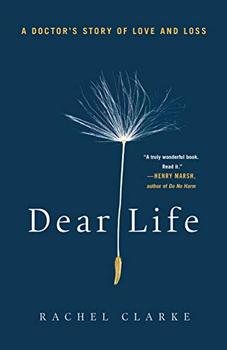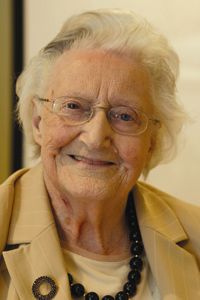Summary | Excerpt | Reviews | Beyond the Book | Read-Alikes | Genres & Themes | Author Bio

 Book Reviewed by:
Book Reviewed by:
Rory L. Aronsky
Buy This Book
This article relates to Dear Life
 In Dear Life, Dr. Rachel Clarke recalls being inspired to shift her medical career from emergency room work to palliative care after serving as a fierce advocate for Pat, her fiancé's dying mother. Cicely Saunders is widely credited with creating palliative care as we know it today. So what inspired Saunders to pursue this particular path?
In Dear Life, Dr. Rachel Clarke recalls being inspired to shift her medical career from emergency room work to palliative care after serving as a fierce advocate for Pat, her fiancé's dying mother. Cicely Saunders is widely credited with creating palliative care as we know it today. So what inspired Saunders to pursue this particular path?
Saunders was born in Barnet in North London in 1918. As a child she was afflicted by a crooked spine, a condition that caused considerable pain. She was also taller than all the other girls at her boarding school. These circumstances produced an affinity for outsiders that informed the rest of her life and her career.
Saunders wanted to be a nurse, but her father was staunchly against it, so she went to St. Anne's College at Oxford, where she studied philosophy, economics and politics, with a view to becoming a secretary for an MP in the House of Commons. World War II motivated her to defy her father and train as a student nurse at St. Thomas' Hospital in London in 1944. However, even though she was recognized as having great promise, her back still gave her immense trouble, and she was advised to quit her training. She went back to Oxford, earned a BA and a Diploma in Public and Social Administration, and in 1947 became a lady almoner, what we call a social worker today.
While working at Archway Hospital, Saunders met and developed strong feelings for David Tasma, a dying 40-year-old Polish Jewish immigrant with whom she discussed her idea of founding a home for dying people to have peace in their final days. He told her, "I'll be a window in your home," and after he died, she found he had left her £500, which amounts to about £21,000 today, or US$28,000.
A year after Saunders met and fell in love with another Polish patient, Antoni Michniewicz. When Michniewicz died in 1960 and her father passed shortly thereafter, Saunders was thrown into an immense whirlwind of grief, causing her to become even more resolute in her mission to build a welcoming, comforting and attentive home for the dying. In addition to her almoner work, she became a volunteer sister at St. Luke's Hospital in North London. The orthopedic surgeon there told her that if she wanted to help the dying, she should become a doctor. She became a medical student at St. Thomas' Hospital at age 33, and qualified as a doctor at 38.
A research scholarship at St. Mary's Hospital led to Saunders studying pain management for terminal patients, and she also worked at St. Joseph's, a hospice in Bayswater in West London. It was there that she pioneered the pain control system that she had begun at St. Luke's, whereby a patient is given relief for their pain at regular intervals instead of having to wait until the pain actually returns. She believed that relieving physical pain also diminishes mental suffering.
With years of academic research and hands-on training under her belt, Saunders was determined to found a new kind of hospice based on her approach to pain management and holistic care. In 1959 she wrote a 10-page proposal and sent it to friends. In it, she described the potential structure and organization for a 60-bed hospice that she named after St. Christopher, the patron saint of travelers. She believed it should provide true care for every part of the person: physical, psychological, spiritual and social. It opened in 1967 in South London with 54 inpatient beds, and soon became a research facility as well. Saunders remained St. Christopher's medical director until 1985, at which point she stepped down from this role but remained chairwoman.
She was the recipient of numerous prizes and honorary titles for her work, including the Templeton Prize for philanthropy and the Conrad N. Hilton Humanitarian Prize. She was designated a Dame Commander of the Order of the British Empire in 1979 — the female equivalent of a knighthood.
Dame Cicely Saunders died at St. Christopher's on July 14, 2005. She never forgot David Tasma. The £500 he left her helped to make her dream a reality, and there is a window dedicated to him at St. Christopher's.
Cicely Saunders, courtesy of St. Christopher's
Filed under People, Eras & Events
![]() This article relates to Dear Life.
It first ran in the September 2, 2020
issue of BookBrowse Recommends.
This article relates to Dear Life.
It first ran in the September 2, 2020
issue of BookBrowse Recommends.





The Flower Sisters
by Michelle Collins Anderson
From the new Fannie Flagg of the Ozarks, a richly-woven story of family, forgiveness, and reinvention.

The House on Biscayne Bay
by Chanel Cleeton
As death stalks a gothic mansion in Miami, the lives of two women intertwine as the past and present collide.

The Funeral Cryer by Wenyan Lu
Debut novelist Wenyan Lu brings us this witty yet profound story about one woman's midlife reawakening in contemporary rural China.
Your guide toexceptional books
BookBrowse seeks out and recommends the best in contemporary fiction and nonfiction—books that not only engage and entertain but also deepen our understanding of ourselves and the world around us.